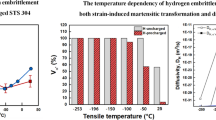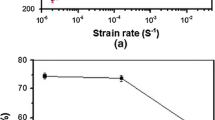Abstract
SA508−III steel was charged with different hydrogen (H) contents using a high-pressure thermal charging method to study the effects of H content on the tensile properties and evaluate the H embrittlement behavior of the steel. The results indicate that the ultimate tensile strength remains nearly unchanged with the addition of H. In contrast, the yielding strength slightly increases, and the elongation significantly decreases with increasing H content, especially at concentrations exceeding 5.6 × 10−6. On the basis of fractographic analysis, it is clear that the addition of H changes the fracture mode from microvoid coalescence to a mixture of river patterns and dimples. Carbides are strong traps for H; thus, the H atoms easily migrate in the form of Cottrell atmosphere toward the carbides following moving dislocations during tensile deformation. In addition, stress-induced H atoms accumulate at the interface between carbides and the matrix after necking under three-dimensional stress, which weakens the interfacial bonding force. Consequently, when the local H concentration reaches a critical value, microcracks occur at the interface, resulting in fracture.
Similar content being viewed by others
References
C.Y. Zhang, P. Chen, J.H. Zhang, J.M. Lin, Y.L. Liu, S.S. Zhang, and B. Wang, Evaluation of the structural integrity of the CPR1000 PWR containment under steam explosion accidents, Nucl. Eng. Des., 278(2014), p. 632.
A.F. Mark, J.A. Francis, H. Dai, M. Turski, P.R. Hurrell, S.K. Bate, J.R. Kornmeier, and P.J. Withers, On the evolution of local material properties and residual stress in a three-pass SA508 steel weld, Acta Mater., 60(2012), No. 8, p. 3268.
T.H. Nam, J.G. Kim, and Y.S. Choi, Electrochemical hydrogen discharge of high-strength low alloy steel for high-pressure gaseous hydrogen storage tank: effect of discharging temperature, Int. J. Hydrogen Energy, 38(2013), No. 2, p. 999.
A. Bousquet, S. Marie, and P. Bompard, Propagation and arrest of cleavage cracks in a nuclear pressure vessel steel, Comput. Mater. Sci., 64(2012), p. 17.
J.Y. Zheng, X.X. Liu, P. Xu, P.F. Liu, Y.Z. Zhao, and J. Yang, Development of high pressure gaseous hydrogen storage technologies, Int. J. Hydrogen Energy, 37(2012), No. 1, p. 1048.
J.S. Park, T.H. Nam, J.S. Kim, and J.G. Kim, Effect of electrotransport treatment on susceptibility of high-strength low alloy steel to hydrogen embrittlement, Int. J. Hydrogen Energy, 38(2013), No. 28, p. 12509.
C.S. Marchi, B.P. Somerday, and S.L. Robinson, Permeability, solubility and diffusivity of hydrogen isotopes in stainless steels at high gas pressures, Int. J. Hydrogen Energy, 32(2007), No. 1, p. 100.
P. Fassina, F. Bolzoni, G. Fumagalli, L. Lazzari, L. Vergani, and A. Sciuccati, Influence of hydrogen and low temperature on pipeline steels mechanical behavior, Procedia Eng., 10(2011), p. 3226.
X.Q. Wu and I.S. Kim, Effects of strain rate and temperature on tensile behavior of hydrogen-charged SA508 Cl.3 pressure vessel steel, Mater. Sci. Eng. A, 348(2003), No. 1-2, p. 309.
S.G. Lee and I.S. Kim, Effect of pre-charged hydrogen on fatigue crack growth of low alloy steel at 288°C, Mater. Sci. Eng. A, 420(2006), No. 1-2, p. 279.
Y.J. Zhang, C. Zhou, W.J. Hui, and H. Dong, Effect of C content on hydrogen induced delayed fracture behavior of Mn-B type steels, J. Iron Steel Res., 26(2014), No. 5, p. 49.
L. Wang, Mechanical Properties of Materials, Northeastern University Press, Shenyang, 2007, p. 92.
M.Y. Sun, L.H. Hao, S.J. Li, D.Z. Li, and Y.Y. Li, Modeling flow stress constitutive behavior of SA508-3 steel for nuclear reactor pressure vessels, J. Nucl. Mater., 418(2011), No. 1-3, p. 269.
J. Chêne and A.M. Brass, Role of temperature and strain rate on the hydrogen-induced intergranular rupture in alloy 600, Metall. Mater. Trans. A, 35(2004), No. 2, p. 457.
F.Q. Wang, L. Wang, Y. Liu, P. Wang, and H. Feng, Effect of hydrogen on fracture toughness and fracture behavior of GH690 alloy, Corros. Sci. Prot. Technol., 22(2010), No. 5, p. 380.
E.O. Hall, Yield Point Phenomena in Metals and Alloys, Macmillan, London, 1970, p. 67.
F.E. Fujita, Hydrogen in Metals, Springer-Verlag, Berlin, 1978, p. 50.
S.J. Zhao and L.M. Zhang, A study on the dislocation density in 300M steel, J. Beijing. Univ. Aeronaut. Astronaut., (1991), No. 1, p. 14.
W.Y. Zhu, H-Induced Damage and Delayed Fracture, Metallurgical Industry Press, Beijing, 1988, p. 56.
J. K. Tien, A.W. Thompson, I.M. Bernstein, and R.J. Richards, Hydrogen transport by dislocations, Metall. Trans. A, 7(1976), No. 6, p. 821.
Author information
Authors and Affiliations
Corresponding author
Rights and permissions
About this article
Cite this article
Liu, Jh., Wang, L., Liu, Y. et al. Effects of H content on the tensile properties and fracture behavior of SA508-III steel. Int J Miner Metall Mater 22, 820–828 (2015). https://doi.org/10.1007/s12613-015-1139-2
Received:
Revised:
Accepted:
Published:
Issue Date:
DOI: https://doi.org/10.1007/s12613-015-1139-2




